毕业设计英语参考文献
英语专业毕业论文文献综述要求和格式
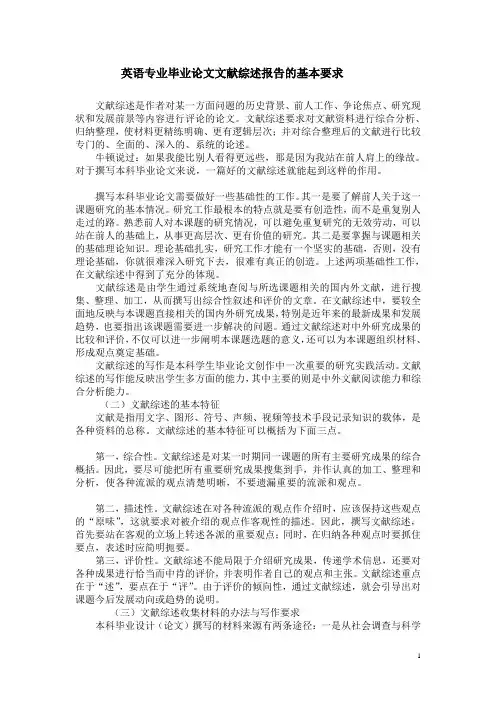
英语专业毕业论文文献综述报告的基本要求文献综述是作者对某一方面问题的历史背景、前人工作、争论焦点、研究现状和发展前景等内容进行评论的论文。
文献综述要求对文献资料进行综合分析、归纳整理,使材料更精练明确、更有逻辑层次;并对综合整理后的文献进行比较专门的、全面的、深入的、系统的论述。
牛顿说过:如果我能比别人看得更远些,那是因为我站在前人肩上的缘故。
对于撰写本科毕业论文来说,一篇好的文献综述就能起到这样的作用。
撰写本科毕业论文需要做好一些基础性的工作。
其一是要了解前人关于这一课题研究的基本情况。
研究工作最根本的特点就是要有创造性,而不是重复别人走过的路。
熟悉前人对本课题的研究情况,可以避免重复研究的无效劳动,可以站在前人的基础上,从事更高层次、更有价值的研究。
其二是要掌握与课题相关的基础理论知识。
理论基础扎实,研究工作才能有一个坚实的基础,否则,没有理论基础,你就很难深入研究下去,很难有真正的创造。
上述两项基础性工作,在文献综述中得到了充分的体现。
文献综述是由学生通过系统地查阅与所选课题相关的国内外文献,进行搜集、整理、加工,从而撰写出综合性叙述和评价的文章。
在文献综述中,要较全面地反映与本课题直接相关的国内外研究成果,特别是近年来的最新成果和发展趋势,也要指出该课题需要进一步解决的问题。
通过文献综述对中外研究成果的比较和评价,不仅可以进一步阐明本课题选题的意义,还可以为本课题组织材料、形成观点奠定基础。
文献综述的写作是本科学生毕业论文创作中一次重要的研究实践活动。
文献综述的写作能反映出学生多方面的能力,其中主要的则是中外文献阅读能力和综合分析能力。
(二)文献综述的基本特征文献是指用文字、图形、符号、声频、视频等技术手段记录知识的载体,是各种资料的总称。
文献综述的基本特征可以概括为下面三点。
第一,综合性。
文献综述是对某一时期同一课题的所有主要研究成果的综合概括。
因此,要尽可能把所有重要研究成果搜集到手,并作认真的加工、整理和分析,使各种流派的观点清楚明晰,不要遗漏重要的流派和观点。
毕业设计英语参考文献
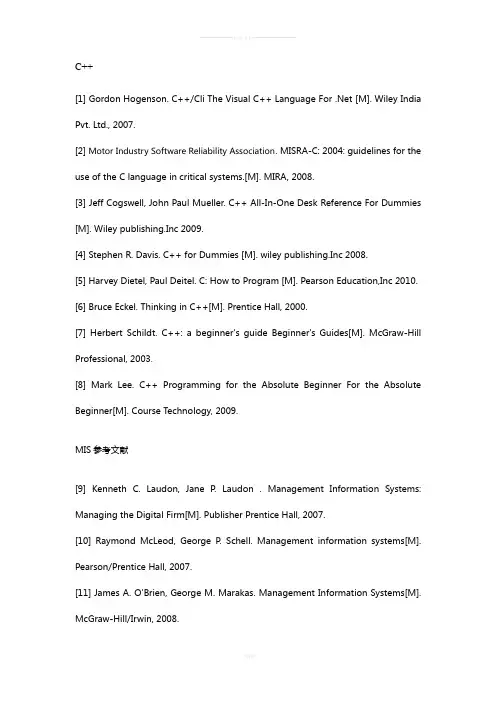
C++[1] Gordon Hogenson. C++/Cli The Visual C++ Language For .Net [M]. Wiley India Pvt. Ltd., 2007.[2] Motor Industry Software Reliability Association. MISRA-C: 2004: guidelines for the use of the C language in critical systems.[M]. MIRA, 2008.[3] Jeff Cogswell, John Paul Mueller. C++ All-In-One Desk Reference For Dummies [M]. Wiley publishing.Inc 2009.[4] Stephen R. Davis. C++ for Dummies [M]. wiley publishing.Inc 2008.[5] Harvey Dietel, Paul Deitel. C: How to Program [M]. Pearson Education,Inc 2010.[6] Bruce Eckel. Thinking in C++[M]. Prentice Hall, 2000.[7] Herbert Schildt. C++: a beginner's guide Beginner's Guides[M]. McGraw-Hill Professional, 2003.[8] Mark Lee. C++ Programming for the Absolute Beginner For the Absolute Beginner[M]. Course Technology, 2009.MIS参考文献[9] Kenneth C. Laudon, Jane P. Laudon . Management Information Systems: Managing the Digital Firm[M]. Publisher Prentice Hall, 2007.[10] Raymond McLeod, George P. Schell. Management information systems[M]. Pearson/Prentice Hall, 2007.[11] James A. O'Brien, George M. Marakas. Management Information Systems[M]. McGraw-Hill/Irwin, 2008.[12] Singh. Information System Management[M]. S.B. Nangia APH publishing Corporation .2007.[13] Kenneth C. Laudon, Jane Price Laudon.Management Information Systems: Managing the Digital Firm MyMISLab Series[M]. Prentice Hall, 2009.数据库参考文献[14] Thomas M. Connolly, Carolyn E. Begg. Database systems: a practical approach to design, implementation, and management[M]. Addison-Wesley, 2009.[15] Abraham Silberschatz, Henry F. Korth, S. Sudar shan. Database System Concepts[M]. McGraw-Hill, 2010.[16] Peter Rob, Carlos Coronel.Database Systems[M]. Cengage Learning EMEA, 2008.[17] J. Stanley Warford. Computer Systems[M]. Jones & Bartlett Publishers, 2009.[18] Toby J. Teorey, Stephen Buxton, Lowell Fryman, Terry Halpin. Database design: know it allKnow It All[M]. Morgan Kaufmann, 2009.[19] John W. Satzinger. Systems Analysis and Design in a Changing World[M]. Cengage Learning EMEA, 2008.SQL 参考文献[20] Alan Beaulieu. Learning SQLO'Reilly Series[M]. O'Reilly Media, Inc., 2009.[21] Clare Churcher. Beginning SQL Queries: From Novice to ProfessionalApress Series[M]. Apress, 2008.[22] Andy Oppel, Robert Sheldon. SQL: a beginner's guide BEGINNER'S GUIDE[M]. McGraw-Hill Professional, 2008.[23] Chris Fehily. SQL: Visual QuickStart Guide Visual Quickstart Guide Series[M]. Peachpit Press, 2008.交通管理参考文献:[24] Peter T. Martin, Aleksandar Stevanovic, Mountain Plains Consortium. Adaptive signal control, five: Sydney Coordinated Adaptive Traffic System evaluation in Park City, Utah Issues 6-200 of MPC report[M]. Mountain-Plains Consortium, 2008. [25] Kenneth J. Button, David A. Hensher. Handbook of transport systems and traffic control Volume 3 of Handbooks in Transportation Research Series[M]. Emerald Group Publishing, 2001.[26] Mashrur A. Chowdhury, Adel Wadid Sadek. Fundamentals of intelligent transportation systems planning Artech House ITS library[M]. Artech House, 2003.[27] Michael A. P. T aylor, Peter W. Bonsall, William Young. Understanding traffic systems: data, analysis, and presentation[M]. Ashgate, 2000.[28] Mike Slinn, Paul Matthews, Peter Guest.Traffic engineering design: principles and practice[M]. Butterworth-Heinemann, 2005.。
土木毕设外文参考文献
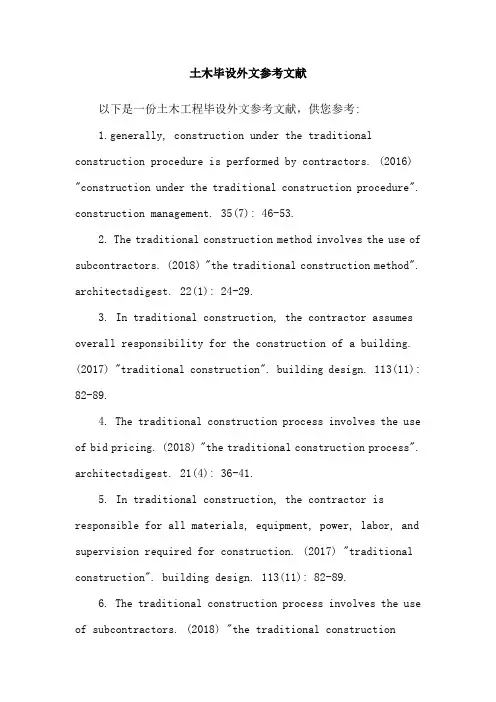
土木毕设外文参考文献以下是一份土木工程毕设外文参考文献,供您参考:1.generally, construction under the traditional construction procedure is performed by contractors. (2016) "construction under the traditional construction procedure". construction management. 35(7): 46-53.2. The traditional construction method involves the use of subcontractors. (2018) "the traditional construction method". architectsdigest. 22(1): 24-29.3. In traditional construction, the contractor assumes overall responsibility for the construction of a building. (2017) "traditional construction". building design. 113(11): 82-89.4. The traditional construction process involves the use of bid pricing. (2018) "the traditional construction process". architectsdigest. 21(4): 36-41.5. In traditional construction, the contractor is responsible for all materials, equipment, power, labor, and supervision required for construction. (2017) "traditional construction". building design. 113(11): 82-89.6. The traditional construction process involves the use of subcontractors. (2018) "the traditional constructionprocess". architectsdigest. 21(4): 36-41.7. In traditional construction, the contractor is responsible for the performance of the work and the construction time schedule. (2017) "traditional construction". building design. 113(11): 82-89.8. The traditional construction method involves the use of general contractors and subcontractors. (2018) "the traditional construction method". architectsdigest. 22(1): 24-29.9. The traditional construction process involves the use of bidding. (2017) "the traditional construction process". architectsdigest. 21(4): 36-41.10. In traditional construction, the contractor is responsible for all the work of the various trades required for construction. (2018) "the traditional construction method". architectsdigest.。
机器人毕业设计参考文献
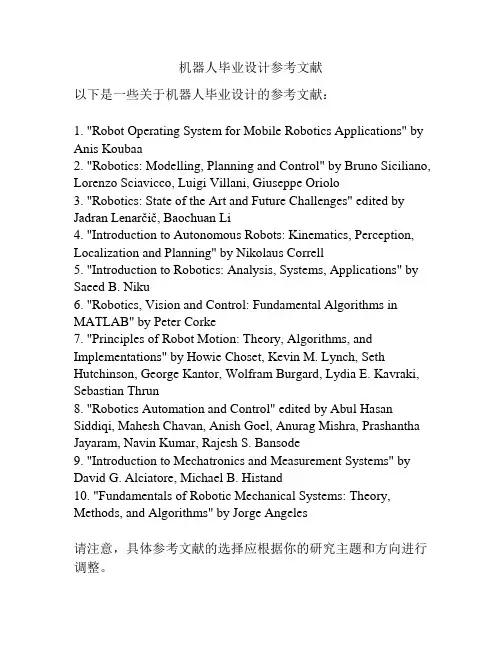
机器人毕业设计参考文献以下是一些关于机器人毕业设计的参考文献:1. "Robot Operating System for Mobile Robotics Applications" by Anis Koubaa2. "Robotics: Modelling, Planning and Control" by Bruno Siciliano, Lorenzo Sciavicco, Luigi Villani, Giuseppe Oriolo3. "Robotics: State of the Art and Future Challenges" edited by Jadran Lenarčič, Baochuan Li4. "Introduction to Autonomous Robots: Kinematics, Perception, Localization and Planning" by Nikolaus Correll5. "Introduction to Robotics: Analysis, Systems, Applications" by Saeed B. Niku6. "Robotics, Vision and Control: Fundamental Algorithms in MATLAB" by Peter Corke7. "Principles of Robot Motion: Theory, Algorithms, and Implementations" by Howie Choset, Kevin M. Lynch, Seth Hutchinson, George Kantor, Wolfram Burgard, Lydia E. Kavraki, Sebastian Thrun8. "Robotics Automation and Control" edited by Abul Hasan Siddiqi, Mahesh Chavan, Anish Goel, Anurag Mishra, Prashantha Jayaram, Navin Kumar, Rajesh S. Bansode9. "Introduction to Mechatronics and Measurement Systems" by David G. Alciatore, Michael B. Histand10. "Fundamentals of Robotic Mechanical Systems: Theory, Methods, and Algorithms" by Jorge Angeles请注意,具体参考文献的选择应根据你的研究主题和方向进行调整。
土木工程毕业设计英文参考文献
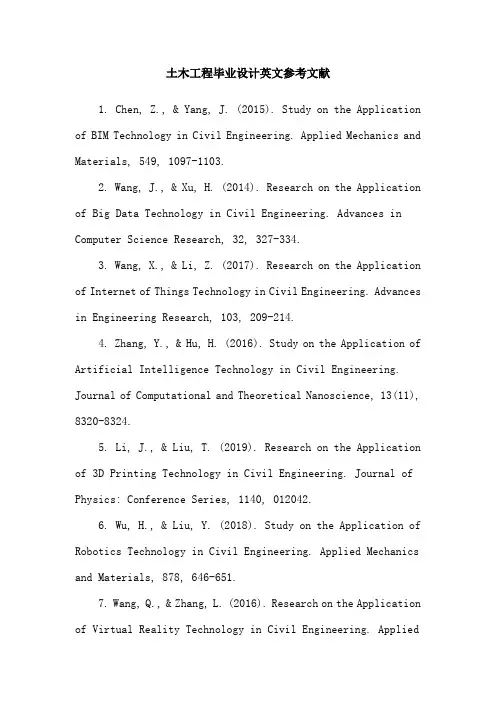
土木工程毕业设计英文参考文献1. Chen, Z., & Yang, J. (2015). Study on the Application of BIM Technology in Civil Engineering. Applied Mechanics and Materials, 549, 1097-1103.2. Wang, J., & Xu, H. (2014). Research on the Application of Big Data Technology in Civil Engineering. Advances in Computer Science Research, 32, 327-334.3. Wang, X., & Li, Z. (2017). Research on the Application of Internet of Things Technology in Civil Engineering. Advances in Engineering Research, 103, 209-214.4. Zhang, Y., & Hu, H. (2016). Study on the Application of Artificial Intelligence Technology in Civil Engineering. Journal of Computational and Theoretical Nanoscience, 13(11), 8320-8324.5. Li, J., & Liu, T. (2019). Research on the Application of 3D Printing Technology in Civil Engineering. Journal of Physics: Conference Series, 1140, 012042.6. Wu, H., & Liu, Y. (2018). Study on the Application of Robotics Technology in Civil Engineering. Applied Mechanics and Materials, 878, 646-651.7. Wang, Q., & Zhang, L. (2016). Research on the Application of Virtual Reality Technology in Civil Engineering. AppliedMechanics and Materials, 864, 485-490.8. Liu, Y., & Wang, X. (2017). Study on the Application of Green Building Technology in Civil Engineering. Advanced Materials Research, 1014, 146-150.9. Zhang, L., & Li, T. (2015). Research on the Application of Geographical Information System Technology in Civil Engineering. International Journal of Environmental, Chemical, Ecological, Geological and Geophysical Engineering, 9(2), 150-154.10. Zhou, H., & Yang, W. (2019). Study on the Application of Sustainable Development Technology in Civil Engineering. Journal of Sustainable Development, 12(5), 15-20.。
毕业设计电动车电池参考文献英文
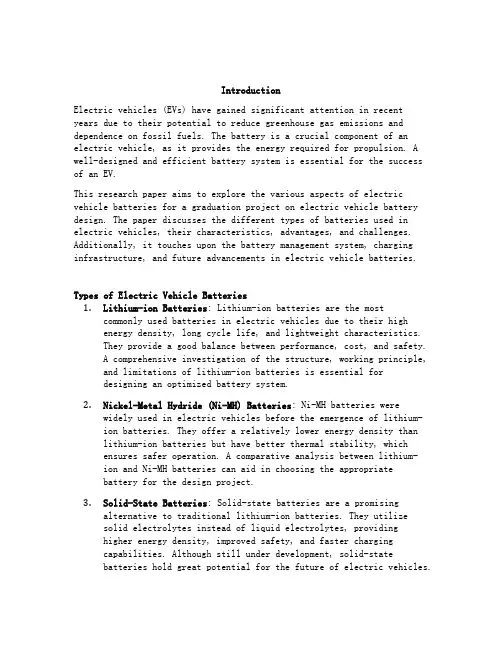
IntroductionElectric vehicles (EVs) have gained significant attention in recent years due to their potential to reduce greenhouse gas emissions and dependence on fossil fuels. The battery is a crucial component of an electric vehicle, as it provides the energy required for propulsion. A well-designed and efficient battery system is essential for the success of an EV.This research paper aims to explore the various aspects of electric vehicle batteries for a graduation project on electric vehicle battery design. The paper discusses the different types of batteries used in electric vehicles, their characteristics, advantages, and challenges. Additionally, it touches upon the battery management system, charging infrastructure, and future advancements in electric vehicle batteries.Types of Electric Vehicle Batteries1.Lithium-ion Batteries: Lithium-ion batteries are the mostcommonly used batteries in electric vehicles due to their highenergy density, long cycle life, and lightweight characteristics.They provide a good balance between performance, cost, and safety.A comprehensive investigation of the structure, working principle,and limitations of lithium-ion batteries is essential fordesigning an optimized battery system.2.Nickel-Metal Hydride (Ni-MH) Batteries: Ni-MH batteries werewidely used in electric vehicles before the emergence of lithium-ion batteries. They offer a relatively lower energy density thanlithium-ion batteries but have better thermal stability, whichensures safer operation. A comparative analysis between lithium-ion and Ni-MH batteries can aid in choosing the appropriatebattery for the design project.3.Solid-State Batteries: Solid-state batteries are a promisingalternative to traditional lithium-ion batteries. They utilizesolid electrolytes instead of liquid electrolytes, providinghigher energy density, improved safety, and faster chargingcapabilities. Although still under development, solid-statebatteries hold great potential for the future of electric vehicles.Battery Management System (BMS)The Battery Management System (BMS) is responsible for monitoring and controlling the battery’s performance, safety, and lifespan. A well-designed BMS ensures the optimal operation of the battery system, preventing overcharging, undercharging, and excessive discharge. It provides accurate state-of-charge (SOC) and state-of-health (SOH) estimations, which are crucial for maximizing the battery’s efficiency.The BMS consists of various components, including sensors, control algorithms, and battery balancing circuits. In-depth research on BMS architecture, functionality, and control strategies is necessary to design an effective battery management system for the electric vehicle.Charging InfrastructureThe availability of a robust charging infrastructure is essential for widespread adoption and convenience of electric vehicles. The research project should explore the different types of charging stations, including:1.Level 1 Charging: Level 1 charging refers to standard householdoutlets (120V), which provide a slow charging rate but are widely accessible.2.Level 2 Charging: Level 2 charging utilizes dedicated chargingstations (240V). It offers a faster charging rate compared toLevel 1 and is commonly found in residential areas, workplaces,and public charging stations.3.DC Fast Charging: DC Fast Charging, also known as Level 3charging, provides rapid charging capabilities by directlydelivering DC power to the vehicle’s battery. These chargingstations are typically located along highways and major routes.The paper should discuss the importance of a well-established charging infrastructure and address potential challenges and solutions to the deployment of charging stations.Future AdvancementsThe field of electric vehicle batteries is continuously evolving, with ongoing research and advancements. It is crucial for the researchproject to explore future developments, such as:1.Advanced Lithium-ion Batteries: Researchers are constantlyworking on improving the energy density, charging speed, andsafety of lithium-ion batteries. Advancements in materials,electrode designs, and electrolytes are expected to result in more efficient and long-lasting batteries.2.Solid-State Batteries: As mentioned earlier, solid-statebatteries hold immense potential for the future of electricvehicles. The research should discuss the current challenges faced in commercializing solid-state batteries and potentialbreakthroughs that can lead to their widespread adoption.3.Beyond Lithium-ion: Besides solid-state batteries, alternativebattery chemistries like lithium-sulfur (Li-S) and lithium-air(Li-Air) batteries are being explored for their high energydensities. Understanding these emerging battery technologies canpave the way for future advancements in EV batteries.ConclusionDesigning an efficient and reliable battery system is crucial for the success of an electric vehicle. This research paper provides a comprehensive and detailed analysis of different types of electric vehicle batteries, their characteristics, and the importance of a well-designed battery management system and charging infrastructure. Furthermore, it explores future advancements in electric vehicle battery technologies. By understanding these aspects, the research project can aim to design an optimized electric vehicle battery system that contributes to a sustainable and greener transportation future.Note: The content provided above is a suggested structure for the research paper related to the topic of “Graduation Project - Electric Vehicle Battery”. Please add relevan t and specific details from appropriate academic references to complete the paper.。
房建毕业设计英文参考文献
房建毕业设计英文参考文献The undergraduate course in civil engineering requires students to complete a final year project, which involves conducting research and writing a dissertation. This process necessitates extensive literature review to gain a comprehensive understanding of the topic, identify existing knowledge gaps, and formulate research questions. Consequently, consulting relevant literature sources is crucial for ensuring the quality and academic rigor of the project. This paper aims to provide a comprehensive list of English reference sources that can be utilized by civil engineering students during their final year project.Firstly, it is essential to consult authoritative textbooks and handbooks in the field of civil engineering. These resources serve as foundational sources of information, offering in-depth explanations of key concepts, theories, and methodologies. Examples of such textbooks include "Structural Analysis" by Hibbeler, "Reinforced Concrete Design" by Nilson et al., and "Foundation Engineering Handbook" by Fang. These texts not only provide theoretical knowledge but also offer practical applications and case studies relevant to various subfields of civil engineering.Furthermore, peer-reviewed journal articles are invaluable sources of the latest research findings and advancements in the field. Renowned journals such as the "Journal of Structural Engineering," "Construction and Building Materials," and "Transportation Research Record" publish cutting-edge research conducted by experts in their respective domains. Accessing these journals through online databases like ScienceDirect, Scopus, or Web of Science can facilitate the discovery of relevant literature tailored to the specific research topic.Online repositories and digital libraries are another essential resource for accessing a wealth of academic literature. Platforms like the American Society of Civil Engineers (ASCE) Library, the Institution of Civil Engineers (ICE) Virtual Library, and the National Technical Information Service (NTIS) offer extensive collections of technical reports, conference proceedings, and research papers related to civil engineering projects. These resources often provide valuable insights and data that may not be readily available in traditional journal publications.Additionally, official guidelines, codes, and standards issued by professional organizations and regulatory bodies are crucial reference materials for civil engineering projects. Documents such as the American Concrete Institute (ACI) Code, the International Building Code (IBC), and the American Association of State Highwayand Transportation Officials (AASHTO) Bridge Design Specifications provide authoritative guidance on design principles, construction practices, and safety regulations that must be adhered to in civil engineering projects.Moreover, government publications and technical reports from agencies like the Federal Highway Administration (FHWA), the Environmental Protection Agency (EPA), and the United States Geological Survey (USGS) can offer valuable information on topics such as infrastructure development, environmental impact assessments, and geotechnical investigations. These resources often present case studies, research findings, and best practices that can inform and guide civil engineering projects.Finally, it is crucial to consider online resources and databases that aggregate and provide access to a wide range of civil engineering literature. Platforms like the ASCE Civil Engineering Database, the Engineering Village, and Google Scholar enable comprehensive searches across various sources, including journals, conference proceedings, dissertations, and technical reports. These resources can significantly streamline the literature review process and ensure that relevant studies are not overlooked.In conclusion, a thorough literature review is essential for the successful completion of a civil engineering final year project. Byconsulting authoritative textbooks, peer-reviewed journals, online repositories, official guidelines, government publications, and comprehensive databases, students can gain a deep understanding of their research topic, identify gaps in existing knowledge, and develop well-informed research questions and methodologies. Leveraging these English reference sources will not only enhance the quality of the project but also contribute to the advancement of knowledge in the field of civil engineering.。
英文参考文献格式
英文参考文献格式篇一:英语论文参考文献格式要求英语专业本科毕业论文参考文献格式要求I.文内引用(一)直接引用1.引用中的省略原始资料的引用:在正文中直接引用时,应给出作者、年份,并用带括号的数字标出页码。
若有任何资料省略,使用英文时,应用3个省略号在句中标出(),中文用6个();若两句间的资料省略,英文应用4个省略号标出(‥‥),中文用6个()。
若要在直接引用插入自己的解释,应使用方括号[ ]。
若在资料中有什么错误拼写、错误语法或标点错误会使读者糊涂,应在引用后立即插入[sic],中文用[原文如此]。
下面是一些示例:例一:The DSM IV defines the disorder [dysthymic] as being in a chronically depressed mood that occurs for most of the day more days than not for at least two years (Criterion A) .... In children, the mood may be irritable rather than depressed, and the required minimum duration is only one year (APA, 1994, p. 345).例二:Issac (1995) states that bipolar disorder is not only uncommon but may be the most diagnostic entity in children and adolescents in similar settings .... and may be the most common diagnosis in adolescents who are court-remanded to such settings (p.275).2.大段落引用当中文引用超过160字时,不使用引号,而使用“块”的形式(引用起于新的一行,首行缩进4个空格,两端对齐,之后每行都缩进)。
计算机毕设英文参考文献
计算机毕设英文参考文献当涉及到毕业设计或者毕业论文的参考文献时,你可以考虑以下一些经典的计算机科学领域的文献:1. D. E. Knuth, "The Art of Computer Programming," Addison-Wesley, 1968.2. A. Turing, "On Computable Numbers, with an Application to the Entscheidungsproblem," Proceedings of the London Mathematical Society, 1936.3. V. Bush, "As We May Think," The Atlantic Monthly, 1945.4. C. Shannon, "A Mathematical Theory of Communication," Bell System Technical Journal, 1948.5. E. W. Dijkstra, "Go To Statement Considered Harmful," Communications of the ACM, 1968.6. L. Lamport, "Time, Clocks, and the Ordering of Events in a Distributed System," Communications of the ACM, 1978.7. T. Berners-Lee, R. Cailliau, "WorldWideWeb: Proposal for a HyperText Project," 1990.8. S. Brin, L. Page, "The Anatomy of a Large-Scale Hypertextual Web Search Engine," Computer Networks and ISDN Systems, 1998.这些文献涵盖了计算机科学领域的一些经典工作,包括算法、计算理论、分布式系统、人机交互等方面的内容。
3D毕业设计论文常用参考文献
文献:1.[美]B·约瑟夫·派恩,詹姆士·H·吉尔摩.体验经济[卜1].北京:机械工业出版社,20022.[美]Donald A Norman.情感化设计[m.北京:电子工业出版社,20053.[法]马克·第亚尼.非物质社会[M].成都:四川人民出版社,19984.[美]B·H·施密特.体验营销[H].经济日报出版社,20045.[美]布里顿.体验:从平凡到卓越的产品策略CM].北京:中信出版社,20036.[英]史密斯.顾客体验品牌化m].北京:机械工业出版社,20047.[美]恰安,沃格尔.创造突破性产品——从产品策略到项目定案的创新[M].北京:机械工业出版社,200452注释:①[法]马克·第亚尼.非物质社会[H].成都:四川人民出版社,1998②金开诚.文艺心理学术语详解辞典[H].北京:北京大学出版社,1992③[美]诺尔曼·丹森.情感论[H].沈阳:辽宁人民出版社,1989④[苏]雅科布松.情感心理学[H].哈尔滨:黑龙江人民出版社,1997⑤[美]唐纳德·A·诺曼.情感化设计[H].北京:电子工业出版社。
2005⑥[美]诺尔曼·丹森.情感论[M].沈阳:辽宁人民出版社,1989色彩:参考文献1.J. Wiley and Sons.《Color Research and Application》.New York∶1976.2.林书尧.《色彩认识论》.台北∶三民书局:1986.3.小林重顺.《色彩行销战略》.台北∶前程企业管理公司:1986.4.大田登and 刘中本.《色彩工学》.西安∶西安交通大学出版社:1997.5.J. 埃姆斯and 赵晓红.《通俗色彩理论: 全新的色彩理论, 以色彩理论指导调色》.北京∶中国建筑工业出版社:1998.6.B. Jane, K. Taylor and 孙建华.《色彩的奥秘》.2000.7.李金花and 韩国I.R.I色彩研究所.《Color Combination色彩设计师配色密码》.北京∶电子工业出版社:2003.8.Heller.Eva and 吴彤.《色彩的文化》.北京∶中央编译出版社:2004.9.吉米.《流行色彩: 与国际同步的中国色彩流行趋势》.北京∶中国城市出版社:2004.10.李明吉, 安文哲and 韩. I.R.I色彩研究所.《色彩设计师营销密码》.北京∶人民邮电出版社:2005.11.潘泰克.斯蒂芬, 罗斯.理查德and 汤凯青.《美国色彩基础教材》.上海∶上海人民美术出版社:2005.12.程杰铭, 陈夏洁and 顾凯.《色彩学》.北京∶科学出版社:2006.13.南云治嘉and 黄文娟.《色彩战略: 色彩设计的商业应用》.北京∶中国。
- 1、下载文档前请自行甄别文档内容的完整性,平台不提供额外的编辑、内容补充、找答案等附加服务。
- 2、"仅部分预览"的文档,不可在线预览部分如存在完整性等问题,可反馈申请退款(可完整预览的文档不适用该条件!)。
- 3、如文档侵犯您的权益,请联系客服反馈,我们会尽快为您处理(人工客服工作时间:9:00-18:30)。
C++
[1] Gordon Hogenson. C++/Cli The Visual C++ Language For .Net [M]. Wiley India Pvt. Ltd., 2007.
[2] Motor Industry Software Reliability Association. MISRA-C: 2004: guidelines for the use of the C language in critical systems.[M]. MIRA, 2008.
[3] Jeff Cogswell, John Paul Mueller. C++ All-In-One Desk Reference For Dummies [M]. Wiley publishing.Inc 2009.
[4] Stephen R. Davis. C++ for Dummies [M]. wiley publishing.Inc 2008.
[5] Harvey Dietel, Paul Deitel. C: How to Program [M]. Pearson Education,Inc 2010.
[6] Bruce Eckel. Thinking in C++[M]. Prentice Hall, 2000.
[7] Herbert Schildt. C++: a beginner's guide Beginner's Guides[M]. McGraw-Hill Professional, 2003.
[8] Mark Lee. C++ Programming for the Absolute Beginner For the Absolute Beginner[M]. Course Technology, 2009.
MIS参考文献
[9] Kenneth C. Laudon, Jane P. Laudon . Management Information Systems: Managing the Digital Firm[M]. Publisher Prentice Hall, 2007.
[10] Raymond McLeod, George P. Schell. Management information systems[M]. Pearson/Prentice Hall, 2007.
[11] James A. O'Brien, George M. Marakas. Management Information Systems[M]. McGraw-Hill/Irwin, 2008.
[12] Singh. Information System Management[M]. S.B. Nangia APH publishing Corporation .2007.
[13] Kenneth C. Laudon, Jane Price Laudon.Management Information Systems: Managing the Digital Firm MyMISLab Series[M]. Prentice Hall, 2009.
数据库参考文献
[14] Thomas M. Connolly, Carolyn E. Begg. Database systems: a practical approach to design, implementation, and management[M]. Addison-Wesley, 2009.
[15] Abraham Silberschatz, Henry F. Korth, S. Sudar shan. Database System Concepts[M]. McGraw-Hill, 2010.
[16] Peter Rob, Carlos Coronel.Database Systems[M]. Cengage Learning EMEA, 2008.
[17] J. Stanley Warford. Computer Systems[M]. Jones & Bartlett Publishers, 2009.
[18] Toby J. Teorey, Stephen Buxton, Lowell Fryman, Terry Halpin. Database design: know it all
Know It All[M]. Morgan Kaufmann, 2009.
[19] John W. Satzinger. Systems Analysis and Design in a Changing World[M]. Cengage Learning EMEA, 2008.
SQL 参考文献
[20] Alan Beaulieu. Learning SQLO'Reilly Series[M]. O'Reilly Media, Inc., 2009.
[21] Clare Churcher. Beginning SQL Queries: From Novice to ProfessionalApress Series[M]. Apress, 2008.
[22] Andy Oppel, Robert Sheldon. SQL: a beginner's guide BEGINNER'S GUIDE[M]. McGraw-Hill Professional, 2008.
[23] Chris Fehily. SQL: Visual QuickStart Guide Visual Quickstart Guide Series[M]. Peachpit Press, 2008.
交通管理参考文献:
[24] Peter T. Martin, Aleksandar Stevanovic, Mountain Plains Consortium. Adaptive signal control, five: Sydney Coordinated Adaptive Traffic System evaluation in Park City, Utah Issues 6-200 of MPC report[M]. Mountain-Plains Consortium, 2008. [25] Kenneth J. Button, David A. Hensher. Handbook of transport systems and traffic control Volume 3 of Handbooks in Transportation Research Series[M]. Emerald Group Publishing, 2001.
[26] Mashrur A. Chowdhury, Adel Wadid Sadek. Fundamentals of intelligent transportation systems planning Artech House ITS library[M]. Artech House, 2003.
[27] Michael A. P. T aylor, Peter W. Bonsall, William Young. Understanding traffic systems: data, analysis, and presentation[M]. Ashgate, 2000.
[28] Mike Slinn, Paul Matthews, Peter Guest.Traffic engineering design: principles and practice[M]. Butterworth-Heinemann, 2005.。
